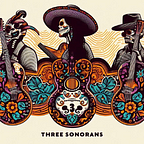Controversial Chaco Canyon study: Ancient DNA unlocks knowledge, but do scientists have a right to Native American remains?
Before Three Sonorans, I used to run a blog called MathGeneRation on Wordpress. In that former lifetime, I was an applied mathematics Ph.D. candidate working in a human genetics laboratory that was interested in using DNA to map human history and migrations. I support this type of research, but this field is not without huge scandals when it comes to their treatment of Native American.
For more background before reading this article, you can read an article written in 2009 entitled “Sad sad science.” A decade later it seems not much as changed when it comes to westerners trying to unlock all the secrets from Native Americans that they have no right to.
However, as the saying goes, it is easier to apologize than to get permission. #GotEthics?
In 1896 archaeologists excavating Pueblo Bonito, a 650-room, multistory brick edifice in northwestern New Mexico’s Chaco Canyon, found the remains of 14 people in a burial crypt. Necklaces, bracelets and other jewelry made up of thousands of turquoise and shell beads accompanied the bones. The artifacts signaled that these individuals were elite members of the ancient Chaco society, one of the most important civilizations in the American Southwest.
The excavations at Pueblo Bonito revealed the splendors of Chaco culture, which flourished between about A.D. 800 and 1250. The ancient Chacoans constructed at least a dozen great houses like Pueblo Bonito in Chaco Canyon during its heyday, and dozens of other Chacoan settlements thrived in what is today the Four Corners region where the borders of New Mexico, Colorado, Arizona and Utah meet. Soon after the excavations ended, archaeologists whisked these human remains off to the American Museum of Natural History (AMNH) in New York City, where most of them have resided ever since.
Every so often researchers take the skulls out of their cardboard storage boxes on the museum’s 5th floor and remove the rest of the bones from wooden drawers lining a nearby hallway, laying them out on long tables to study them. They want to know how these people were related to one another and what this elite group might say about how Chaco society was organized. But they have had only limited clues.
Continuing excavations at Chaco over the years have suggested that most people lived in smaller adobe residences surrounding the great houses, leading the majority of archaeologists to conclude Chaco society was hierarchically structured: Elite groups had dominion over cultural, religious and political life and enjoyed special privileges. Now an analysis of DNA from the Pueblo Bonito remains is providing intimate new details about these elite groups and who belonged to them. In a paper published online this week in Nature Communications researchers report the remains belonged to a single maternal line — what the team calls a matrilineal “dynasty” — that lasted for centuries. Other scientists hailed the research as a technical tour de force that helps fulfill the promise of ancient DNA to reveal the lives of ancient peoples. But not everyone agrees with the team’s conclusions, and some experts have criticized their decision not to consult with indigenous groups before going ahead with the research.
Source: Ancient DNA Yields Unprecedented Insights into Mysterious Chaco Civilization — Scientific American
The article goes on to document the racial insensitivity of researchers desecrating Native burial grounds and sequencing DNA to unlock secrets of which they have no right.
But that decision does not sit well with some critics. “Despite the fact the authors’ work was technically legal, the ethics here are questionable,” says Chaco researcher Ruth Van Dyke of Binghamton University in New York State. “Studies using ancient indigenous DNA should not be done without tribal consultation.”
Rebecca Tsosie, a law professor of Native American descent at the University of Arizona who specializes in tribal and U.S. Indian law, agrees. “I am dismayed that there was not an effort to engage contemporary tribal leaders prior to undertaking and publishing this study,” Tsosie says, adding that the research is a “prime example” of “a study by cultural outsiders to dictate the truth of the history and structure of governance of the cultural insiders, Pueblo Indian nations.”
Originally published at TSON News.
